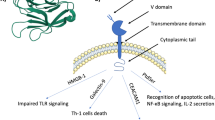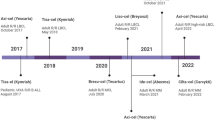Abstract
Tumor-mediated immunosuppression via regulatory T-cells is a key player among the various immune-escape mechanisms in multiple myeloma. We analyzed the generation, distribution, function and immunophenotype of CD8+CD28− regulatory T-cells in patients with multiple myeloma. Functionality of CD8+CD28− T-cells was assessed by immunological assays using ex vivo generated antigen-specific T-cells from patients with plasma cell dyscrasias and healthy donors. Detailed analysis of distribution, immunophenotype and cytotoxic potential of CD8+CD28− T-cells was performed by flow cytometry and ELISA. We found that the amount of CD8+CD28− T-cells was directly correlated with the suppression of antigen-specific T-cell responses in patients with plasma cell dyscrasia. Analyzing the CD8+CD28− T-cells in detail, increased numbers of these cells were observed in the bone marrow (i.e., tumor microenvironment) of patients with plasma cell dyscrasia. Furthermore, we identified the expression of lymphocyte function-associated antigen 1 (LFA-1) as a marker of immunosuppression and defined the CD8+CD28−CD57+LFA-1high population as the relevant immunosuppressive compartment. These regulatory T-cells act as immunosuppressors via soluble factors and incubation with IL-10 augmented their immunosuppressive capacity. The immunosuppressive regulatory network of IL-10 and the CD8+CD28−CD57+LFA-1high regulatory T-cells show unique characteristics and contribute to the tumor immune escape mechanism in patients with multiple myeloma.






Similar content being viewed by others
Abbreviations
- APD:
-
Advanced plasma-cell disease
- EPD:
-
Early plasma-cell disease
- HD:
-
Healthy donor
- LFA-1:
-
Lymphocyte function-associated antigen 1
- MGUS:
-
Monoclonal gammopathy of undetermined significance
- MM:
-
Multiple myeloma
- MNC:
-
Mononuclear cells
- PB:
-
Peripheral blood
- PCD:
-
Plasma cell dyscrasia
- SLE:
-
Systemic lupus erythematosus
References
Fagnoni FF, Vescovini R, Mazzola M, Bologna G, Nigro E, Lavagetto G, Franceschi C, Passeri M, Sansoni P (1996) Expansion of cytotoxic CD8+ CD28− T cells in healthy ageing people, including centenarians. Immunology 88(4):501–507
Strioga M, Pasukoniene V, Characiejus D (2011) CD8+ CD28− and CD8+ CD57+ T cells and their role in health and disease. Immunology 134(1):17–32. https://doi.org/10.1111/j.1365-2567.2011.03470.x
Filaci G, Bacilieri S, Fravega M, Monetti M, Contini P, Ghio M, Setti M, Puppo F, Indiveri F (2001) Impairment of CD8+ T suppressor cell function in patients with active systemic lupus erythematosus. J Immunol 166(10):6452–6457
Filaci G, Fenoglio D, Fravega M, Ansaldo G, Borgonovo G, Traverso P, Villaggio B, Ferrera A, Kunkl A, Rizzi M, Ferrera F, Balestra P, Ghio M, Contini P, Setti M, Olive D, Azzarone B, Carmignani G, Ravetti JL, Torre G, Indiveri F (2007) CD8+ CD28- T regulatory lymphocytes inhibiting T cell proliferative and cytotoxic functions infiltrate human cancers. J Immunol 179(7):4323–4334
Balashov KE, Khoury SJ, Hafler DA, Weiner HL (1995) Inhibition of T cell responses by activated human CD8+ T cells is mediated by interferon-gamma and is defective in chronic progressive multiple sclerosis. J Clin Invest 95(6):2711–2719. https://doi.org/10.1172/JCI117973
Valenzuela HF, Effros RB (2002) Divergent telomerase and CD28 expression patterns in human CD4 and CD8 T cells following repeated encounters with the same antigenic stimulus. Clin Immunol 105(2):117–125
Monteiro J, Batliwalla F, Ostrer H, Gregersen PK (1996) Shortened telomeres in clonally expanded CD28-CD8+ T cells imply a replicative history that is distinct from their CD28+ CD8+ counterparts. J Immunol 156(10):3587–3590
Borthwick NJ, Lowdell M, Salmon M, Akbar AN (2000) Loss of CD28 expression on CD8(+) T cells is induced by IL-2 receptor gamma chain signalling cytokines and type I IFN, and increases susceptibility to activation-induced apoptosis. Int Immunol 12(7):1005–1013
Chiu WK, Fann M, Weng NP (2006) Generation and growth of CD28nullCD8+ memory T cells mediated by IL-15 and its induced cytokines. J Immunol 177(11):7802–7810
Filaci G, Rizzi M, Setti M, Fenoglio D, Fravega M, Basso M, Ansaldo G, Ceppa P, Borgonovo G, Murdaca G, Ferrera F, Picciotto A, Fiocca R, Torre G, Indiveri F (2005) Non-antigen-specific CD8(+) T suppressor lymphocytes in diseases characterized by chronic immune responses and inflammation. Ann N Y Acad Sci 1050:115–123. https://doi.org/10.1196/annals.1313.013
Filaci G, Fravega M, Negrini S, Procopio F, Fenoglio D, Rizzi M, Brenci S, Contini P, Olive D, Ghio M, Setti M, Accolla RS, Puppo F, Indiveri F (2004) Nonantigen specific CD8+ T suppressor lymphocytes originate from CD8+ CD28− T cells and inhibit both T-cell proliferation and CTL function. Hum Immunol 65(2):142–156. https://doi.org/10.1016/j.humimm.2003.12.001
Meloni F, Morosini M, Solari N, Passadore I, Nascimbene C, Novo M, Ferrari M, Cosentino M, Marino F, Pozzi E, Fietta AM (2006) Foxp3 expressing CD4+ CD25+ and CD8+ CD28− T regulatory cells in the peripheral blood of patients with lung cancer and pleural mesothelioma. Hum Immunol 67(1–2):1–12. https://doi.org/10.1016/j.humimm.2005.11.005
Bernuzzi F, Fenoglio D, Battaglia F, Fravega M, Gershwin ME, Indiveri F, Ansari AA, Podda M, Invernizzi P, Filaci G (2010) Phenotypical and functional alterations of CD8 regulatory T cells in primary biliary cirrhosis. J Autoimmun 35(3):176–180. https://doi.org/10.1016/j.jaut.2010.06.004
Raja KR, Plasil M, Rihova L, Pelcova J, Adam Z, Hajek R (2013) Flow cytometry based enumeration and functional characterization of CD8 T regulatory cells in patients with multiple myeloma before and after lenalidomide plus dexamethasone treatment. Cytometry B Clin Cytom. https://doi.org/10.1002/cytob.21109
Zelle-Rieser C, Thangavadivel S, Biedermann R, Brunner A, Stoitzner P, Willenbacher E, Greil R, Johrer K (2016) T cells in multiple myeloma display features of exhaustion and senescence at the tumor site. J Hematol Oncol 9(1):116. https://doi.org/10.1186/s13045-016-0345-3
Christensen O, Lupu A, Schmidt S, Condomines M, Belle S, Maier A, Hose D, Neuber B, Moos M, Kleist C, Terness P, Ho AD, Goldschmidt H, Klein B, Hundemer M (2009) Melan-A/MART1 analog peptide triggers anti-myeloma T-cells through crossreactivity with HM1.24. J Immunother 32(6):613–621. https://doi.org/10.1097/CJI.0b013e3181a95198
Neuber B, Herth I, Tolliver C, Schoenland S, Hegenbart U, Hose D, Witzens-Harig M, Ho AD, Goldschmidt H, Klein B, Hundemer M (2011) Lenalidomide enhances antigen-specific activity and decreases CD45RA expression of T cells from patients with multiple myeloma. J Immunol 187(2):1047–1056. https://doi.org/10.4049/jimmunol.1002460
Hundemer M, Schmidt S, Condomines M, Lupu A, Hose D, Moos M, Cremer F, Kleist C, Terness P, Belle S, Ho AD, Goldschmidt H, Klein B, Christensen O (2006) Identification of a new HLA-A2-restricted T-cell epitope within HM1.24 as immunotherapy target for multiple myeloma. Exp Hematol 34(4):486–496. https://doi.org/10.1016/j.exphem.2006.01.008
Munder M, Engelhardt M, Knies D, Medenhoff S, Wabnitz G, Luckner-Minden C, Feldmeyer N, Voss RH, Kropf P, Muller I, Conradi R, Samstag Y, Theobald M, Ho AD, Goldschmidt H, Hundemer M (2013) Cytotoxicity of tumor antigen specific human T cells is unimpaired by arginine depletion. PLoS One 8(5):e63521. https://doi.org/10.1371/journal.pone.0063521
Paccani SR, Finetti F, Davi M, Patrussi L, D’Elios MM, Ladant D, Baldari CT (2011) The Bordetella pertussis adenylate cyclase toxin binds to T cells via LFA-1 and induces its disengagement from the immune synapse. J Exp Med 208(6):1317–1330. https://doi.org/10.1084/jem.20101558
Munder M, Schneider H, Luckner C, Giese T, Langhans CD, Fuentes JM, Kropf P, Mueller I, Kolb A, Modolell M, Ho AD (2006) Suppression of T-cell functions by human granulocyte arginase. Blood 108(5):1627–1634. https://doi.org/10.1182/blood-2006-11-010389
Stanislawski T, Voss RH, Lotz C, Sadovnikova E, Willemsen RA, Kuball J, Ruppert T, Bolhuis RL, Melief CJ, Huber C, Stauss HJ, Theobald M (2001) Circumventing tolerance to a human MDM2-derived tumor antigen by TCR gene transfer. Nat Immunol 2(10):962–970. https://doi.org/10.1038/ni1001-962
Voss RH, Kuball J, Engel R, Guillaume P, Romero P, Huber C, Theobald M (2006) Redirection of T cells by delivering a transgenic mouse-derived MDM2 tumor antigen-specific TCR and its humanized derivative is governed by the CD8 coreceptor and affects natural human TCR expression. Immunol Res 34(1):67–87. https://doi.org/10.1385/IR:34:1:67
Knies D, Klobuch S, Xue SA, Birtel M, Echchannaoui H, Yildiz O, Omokoko T, Guillaume P, Romero P, Stauss H, Sahin U, Herr W, Theobald M, Thomas S, Voss RH (2016) An optimized single chain TCR scaffold relying on the assembly with the native CD3-complex prevents residual mispairing with endogenous TCRs in human T-cells. Oncotarget 7(16):21199–21221. https://doi.org/10.18632/oncotarget.8385
Frassanito MA, Silvestris F, Cafforio P, Dammacco F (1998) CD8+/CD57 cells and apoptosis suppress T-cell functions in multiple myeloma. Br J Haematol 100(3):469–477
Focosi D, Marco T, Kast RE, Maggi F, Ceccherini-Nelli L, Petrini M (2010) Progressive multifocal leukoencephalopathy: what’s new? Neuroscientist 16(3):308–323. https://doi.org/10.1177/1073858409356594
Frassanito MA, Silvestris F, Silvestris N, Cafforio P, Camarda G, Iodice G, Dammacco F (1998) Fas/Fas ligand (FasL)-deregulated apoptosis and IL-6 insensitivity in highly malignant myeloma cells. Clin Exp Immunol 114(2):179–188
Verma NK, Kelleher D (2014) Adaptor regulation of LFA-1 signaling in T lymphocyte migration: potential druggable targets for immunotherapies? Eur J Immunol 44(12):3484–3499. https://doi.org/10.1002/eji.201344428
Chattopadhyay PK, Betts MR, Price DA, Gostick E, Horton H, Roederer M, De Rosa SC (2009) The cytolytic enzymes granzyme A, granzyme B, and perforin: expression patterns, cell distribution, and their relationship to cell maturity and bright CD57 expression. J Leukoc Biol 85(1):88–97. https://doi.org/10.1189/jlb.0208107
Weng NP, Akbar AN, Goronzy J (2009) CD28(−) T cells: their role in the age-associated decline of immune function. Trends Immunol 30(7):306–312. https://doi.org/10.1016/j.it.2009.03.013
Monks CR, Freiberg BA, Kupfer H, Sciaky N, Kupfer A (1998) Three-dimensional segregation of supramolecular activation clusters in T cells. Nature 395(6697):82–86. https://doi.org/10.1038/25764
Kandula S, Abraham C (2004) LFA-1 on CD4+ T cells is required for optimal antigen-dependent activation in vivo. J Immunol 173(7):4443–4451
Shier P, Otulakowski G, Ngo K, Panakos J, Chourmouzis E, Christjansen L, Lau CY, Fung-Leung WP (1996) Impaired immune responses toward alloantigens and tumor cells but normal thymic selection in mice deficient in the beta2 integrin leukocyte function-associated antigen-1. J Immunol 157(12):5375–5386
Perez OD, Mitchell D, Jager GC, South S, Murriel C, McBride J, Herzenberg LA, Kinoshita S, Nolan GP (2003) Leukocyte functional antigen 1 lowers T cell activation thresholds and signaling through cytohesin-1 and Jun-activating binding protein 1. Nat Immunol 4(11):1083–1092. https://doi.org/10.1038/ni984
Graf B, Bushnell T, Miller J (2007) LFA-1-mediated T cell costimulation through increased localization of TCR/class II complexes to the central supramolecular activation cluster and exclusion of CD45 from the immunological synapse. J Immunol 179(3):1616–1624
Anikeeva N, Somersalo K, Sims TN, Thomas VK, Dustin ML, Sykulev Y (2005) Distinct role of lymphocyte function-associated antigen-1 in mediating effective cytolytic activity by cytotoxic T lymphocytes. Proc Natl Acad Sci USA 102(18):6437–6442. https://doi.org/10.1073/pnas.0502467102
Guan Y, Jiang Z, Ciric B, Rostami AM, Zhang GX (2008) Upregulation of chemokine receptor expression by IL-10/IL-4 in adult neural stem cells. Exp Mol Pathol 85(3):232–236. https://doi.org/10.1016/j.yexmp.2008.07.003
Fenoglio D, Ferrera F, Fravega M, Balestra P, Battaglia F, Proietti M, Andrei C, Olive D, Antonio LC, Indiveri F, Filaci G (2008) Advancements on phenotypic and functional characterization of non-antigen-specific CD8+ CD28− regulatory T cells. Hum Immunol 69(11):745–750. https://doi.org/10.1016/j.humimm.2008.08.282
Cao X, Cai SF, Fehniger TA, Song J, Collins LI, Piwnica-Worms DR, Ley TJ (2007) Granzyme B and perforin are important for regulatory T cell-mediated suppression of tumor clearance. Immunity 27(4):635–646. https://doi.org/10.1016/j.immuni.2007.08.014
Efimova OV, Kelley TW (2009) Induction of granzyme B expression in T-cell receptor/CD28-stimulated human regulatory T cells is suppressed by inhibitors of the PI3K-mTOR pathway. BMC Immunol 10:59. https://doi.org/10.1186/1471-2172-10-59
Funding
No relevant funding.
Author information
Authors and Affiliations
Contributions
Study conception and design: Julian Plaumann, Melanie Engelhardt, Michael Hundemer. Acquisition of data: Julian Plaumann, Melanie Engelhardt, Brigitte Neuber, Eva Amman. Analysis and interpretation of data: Julian Plaumann, Melanie Engelhardt, Eva Amman, Hakim Echchannaoui, Mohamed H. S. Awwad, Michael Hundemer. Drafting of manuscript: Julian Plaumann, Michael Hundemer. Critical revision: Mohamed H. S. Awwad, Marc S. Raab, Jens Hillengass, Niels Halama, Carsten Müller-Tidow, Hartmut Goldschmidt.
Corresponding author
Ethics declarations
Conflict of interest
The authors declare that they have no conflict of interest.
Ethical approval
All human studies were performed after obtaining written informed consent in accordance with the Declaration of Helsinki and were approved by the ethics committee of the Medical Faculty, University of Heidelberg according to the institutional guidelines. Data safety management was performed according to the data safety regulations of the University Hospital Heidelberg.
Informed consent
Informed consent was obtained from all individual participants included in the study.
Electronic supplementary material
Below is the link to the electronic supplementary material.
Rights and permissions
About this article
Cite this article
Plaumann, J., Engelhardt, M., Awwad, M.H.S. et al. IL-10 inducible CD8+ regulatory T-cells are enriched in patients with multiple myeloma and impact the generation of antigen-specific T-cells. Cancer Immunol Immunother 67, 1695–1707 (2018). https://doi.org/10.1007/s00262-018-2230-0
Received:
Accepted:
Published:
Issue Date:
DOI: https://doi.org/10.1007/s00262-018-2230-0




